|
Early History
of the
Pleasant Ridge Presbyterian Church
Pleasant Ridge, Greene County, Alabama
by Scott W. Owens
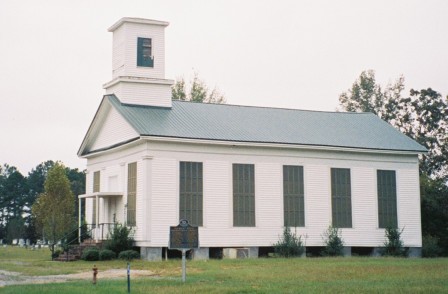 In accordance with an appointment of the Tuscaloosa Presbytery, Rev. J. L.
Kirkpatrick and Rev C. A. Stillman met on November 18, 1848, and organized a
Presbyterian church at Pleasant Ridge. The church was formed with the following charter
members: James H. Archibald, Mary A. Archibald, Elizabeth Archibald, Samuel S. Archibald,
Andrew B. Archibald, William Steele, Eleanore Steele, Elizabeth W. Steele, William P.
Kennedy, Elizabeth A. Kennedy, James M. Kennedy, William Leroy Kennedy, and Elizabeth A.
Hutchins. The Steeles and Archibalds had been members at Mesopotamia Presbyterian Church
in Eutaw, the Kennedys and Miss Hutchins from the Ebenezer Presbyterian Church in Clinton.
Rev. Stillman preached from I Timothy 5:17 at the organizational service, with Rev.
Kirkpatrick presiding, this service being held at a home near the present site of the
church. On motion it was resolved that the church elect three ruling elders. Elected as
the first Session of the Pleasant Ridge Presbyterian Church were: James H. Archibald,
William Steele, and Dr. William P. Kennedy. All these men had previously been
ordained as ruling elders; they were installed at the organization as elders of this
church. Dr. Kennedy was elected Clerk of the Session. Rev. J. L. Kirkpatrick then gave a
charge to the elders and also to the people. It was then determined by a vote of the
congregation that this church be called Pleasant Ridge Presbyterian Church. In accordance with an appointment of the Tuscaloosa Presbytery, Rev. J. L.
Kirkpatrick and Rev C. A. Stillman met on November 18, 1848, and organized a
Presbyterian church at Pleasant Ridge. The church was formed with the following charter
members: James H. Archibald, Mary A. Archibald, Elizabeth Archibald, Samuel S. Archibald,
Andrew B. Archibald, William Steele, Eleanore Steele, Elizabeth W. Steele, William P.
Kennedy, Elizabeth A. Kennedy, James M. Kennedy, William Leroy Kennedy, and Elizabeth A.
Hutchins. The Steeles and Archibalds had been members at Mesopotamia Presbyterian Church
in Eutaw, the Kennedys and Miss Hutchins from the Ebenezer Presbyterian Church in Clinton.
Rev. Stillman preached from I Timothy 5:17 at the organizational service, with Rev.
Kirkpatrick presiding, this service being held at a home near the present site of the
church. On motion it was resolved that the church elect three ruling elders. Elected as
the first Session of the Pleasant Ridge Presbyterian Church were: James H. Archibald,
William Steele, and Dr. William P. Kennedy. All these men had previously been
ordained as ruling elders; they were installed at the organization as elders of this
church. Dr. Kennedy was elected Clerk of the Session. Rev. J. L. Kirkpatrick then gave a
charge to the elders and also to the people. It was then determined by a vote of the
congregation that this church be called Pleasant Ridge Presbyterian Church.
The Session met after the services of organization, Rev. Kirkpatrick presiding and
opening with prayer. The following persons presented themselves to the Session for
admission into the communion of the church, and upon examination as to their religious
experience were received: J. A. Williams, R. T. Kennedy, Joseph Benton, Mary Benton, Mary
Bostick, and Ann J. Bostick.
The church continued to meet in the home for services. The pulpit was filled by stated
supplies A. P. Silliman in 1849 and Fields Bradshaw in 1851, as well as Rev. C. A.
Stillman, R. W. B. Kennedy, and M. Calvin from 1848-1855. The first infant
baptized in the church was Samuel Miller Archibald, son of Edwin Addison and Ellen Jane
Archibald, on March 14, 1851 by Rev. N. R. Morgan. By this time there were
twenty-three communicant members of the congregation. On February 18, 1854, the church
elected, ordained, and installed its first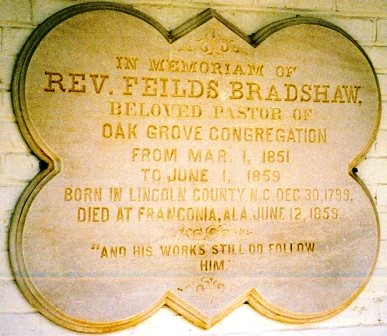 deacons, Samuel S. Archibald and Richard
M. Kennedy. This same day, Edwin Addison Archibald was elected ruling elder of
the church. deacons, Samuel S. Archibald and Richard
M. Kennedy. This same day, Edwin Addison Archibald was elected ruling elder of
the church.
On September 8, 1855, the 41 communicant members convened in a Congregational Meeting,
Rev. R. W. B. Kennedy presiding. After a
reading a portion of Scripture, singing, and prayer, the moderator proceeded to take the
votes of the congregation for Pastor of the same. Whereupon Rev. J. P. McMullen was
unanimously elected. A call was then drawn in due form, and subscribed to by the Electors. Thus the Pleasant Ridge Presbyterian Church
called its first pastor.
James Porter McMullen was born July 21, 1811 in Abbeville District, South Carolina,
the youngest son of Archibald and Mary (Dunlap) McMullen, members of the Associate
Reformed Church. He did not profess Christ until the twenty-third year of his life. When
he reached manhood, he moved to Alabama where his brother Robert B. McMullen, D.D., then
resided. At a Tuscaloosa Presbytery meeting at Eutaw, at the Mesopotamia Presbyterian
Church, in 1833 that he joined himself to the church, and shortly thereafter he gave
himself to the sacred ministry. He attended the Manuel
Labor School@ at Marion, Alabama during
the years 1834 and 1835 to begin his literary education. Thereafter he entered Franklin
College in Athens, Georgia in 1836, graduating with honors in 1838. On November 4, 1838,
James married Miss Martha S. Fulton at the Ebenezer Presbyterian Church in Clinton. James
was a member of this church until at least 1840. He studied theology privately under the
direction of his brother the Rev. Dr. McMullen until 1841. In April of 1841 he was
licensed by the Tuscaloosa Presbytery and in December he was ordained and installed as
pastor of the churches of Mt. Zion, Concord, and Carthage Presbyterian churches in eastern
Greene County, now Hale County. Here he labored thirteen years, and was much blessed in
the successful result of his ministry.
Upon his acceptance of the call to pastorship by the Pleasant Ridge church, James P.
McMullen was also pastor of the Bethesda Presbyterian Church in Pickens County.
Snedecors Greene County Directory, 1856
indicates that Mr. McMullen also pastored the New Hope Church in Knoxville, some distance
to the northeast.
The effects of his ministry at Pleasant Ridge were even more fruitful than his previous
ministry in eastern Greene County. From 1855 to 1860 eighty-three members were added to
the rolls of the church, including twenty African-American members. The first of these was
Jacob, servant of William Porter, who was received into full communion of the church on
letter of the Hebron Presbyterian Church in Union. Although all the African-American
members were servants in the community, half of those who joined the church during this
antebellum period were servants whose masters were not members themselves or most
certainly did not attend the church, or were members at churches of other denominations in
the community. Clearly the African-American members attended the services of this church
by their own choice. Session records reveal that examination of religious experience,
admission to membership, and matters of church discipline were administered equally
regardless of race or social status. On March 14, 1856, the church elected James M.
McGowan ruling elder.
With the growth of the congregation a permanent and appropriate house of worship was
needed. In 1859 a Greek Revival church building was constructed on land which had been
purchased on the Mouth of Sipsey road, near the Baptist church. The central double
entrance doors led to a shallow vestibule, with stairs in the right corner leading to the
upper gallery entirely above the vestibule. The double isle sanctuary was heated by pot
belly stoves at the four corners. The rostrum at the front was surmounted by a railing,
with a box pulpit. Walls and ceilings were plastered; woodwork was stained oak. Three
brass whale oil chandeliers were over each isle, with one larger chandelier over the
pulpit. The tower over the west facade was fitted with louvers in the belfry. A hipped
copper roof topped the bell tower.
During this time the church mourned the death of one of the founding elders. On
February 17, 1859, Mr. William Steele died at his home in Pleasant Ridge. A lengthy
tribute to Mr. Steele was prepared by the Session and published in the Tuscaloosa
Presbyterian. George Washington Knox and Abner Alexander Archibald were
elected ruling elders January 28, 1860.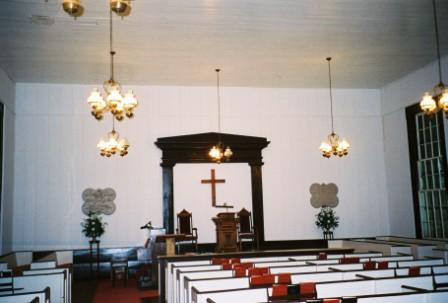
With the coming national crisis in 1861, the growth of the church continued under Mr.
McMullen=s ministry. While no new members
were received in 186l, a couple and their servant were received on letter, as a family, in
1862; one communicant joined in 1863 and seventeen in 1864, the latter number including
three African-Americans. During 1861 and 1862 many of the men of the church answered the
call of the colors. No less than twenty-five members of the Pleasant Ridge church are
documented in Confederate service. This little church furnished two chaplains, one each
for the two major field armies. William P. Kennedy, a founding elder, was chaplain of the
11th Alabama Infantry in the Army of Northern Virginia; the pastor himself answered the
call of the chaplaincy in 1864, ministering to the 42nd Alabama Infantry of the Army of
Tennessee. Of those who served in their country=s
armies, eleven did not return:
James William Horton was the son of William Horton, a substantial planter in
Pleasant Ridge. The Hortons were members of the Baptist church, but on September 20, 1860,
James was received into membership in the Pleasant Ridge Presbyterian church on
examination of his religious experience. Nine months later, June 11, 1861, James enlisted
in Company C, 11th Alabama Infantry for the duration of the war. He arrived with the
regiment in Manasass, Virginia shortly after the battle there in July. On July 24 he was
admitted to the General Hospital in Charlottesville, Virginia, and was discharged July 31.
In August he was present with the regiment in camp at Bristoe and Centreville near
Manasass. In September 1861 James contracted typhoid fever and died in camp on September
20, 1861, one year to the day after he had joined with the Pleasant Ridge church.
Robert N. Archibald was the son of Robert and Mary Archibald, and he became a
founding member of the church on his letter from Mesopotamia church in Eutaw on November
18, 1848. He enlisted in Company C, 11th Alabama Infantry, on June 11, 1861, and was
present with the regiment throughout 1861 and early 1862. On June 27, 1862, the second day
of Lee=s offensive against the Northern
Army of the Potomac, Robert N. Archibald was killed in action in the Battle of Gaines= Mill.
William M. Garrow was received into the membership of the Pleasant Ridge church on
May 30, 1857 on examination of his religious experience. He enlisted in Company K, 3rd
Alabama Infantry on April 24, 1861 in Mobile. He was present with the regiment through
February 1862. Church records indicate that he was killed in action in a battle around
Richmond, Virginia, likely during the Seven Days=
campaign in June 1862.
Robert Hinds Miller, the son of William Miller of Pleasant Ridge, was received on
examination of the Session of the Pleasant Ridge church on September 18, 1860. Over a year
later he enlisted in Company E, 20th Alabama Infantry on October 31, 1861. He was
appointed Fourth Corporal of the company on July 7, 1862, and on December 17, 1862 was
promoted to Third Corporal. On May 16, 1863 he was wounded in the Battle of Baker=s Creek, Mississippi, and he died of these
wounds in Vicksburg soon after on May 25, 1863.
Thomas Hall Steele, son of William Steele, founding elder, was received on
examination into the membership on September 23, 1853. He enlisted in Co B, 36th Alabama
Infantry. On September 21, 1863, ten years later, he was killed in action at the Battle of
Chickamauga, Georgia.
Andrew W. McGowen, son of elder James M. McGowen, was received into membership of
the Pleasant Ridge church by certificate on July 29, 1856. He enlisted in Company D, 42nd
Alabama Infantry on March 17, 1862, and was commissioned 2nd Lieutenant on May 10, 1862.
On April 23, 1863 he was commissioned a 1st Lieutenant. He was captured at Vicksburg July
4, 1863 and paroled July 10. On November 25, 1863, Andrew W. McGowen was killed in action
at the Battle of Missionary Ridge, Tennessee.
Andrew B. Archibald, son of elder James H. Archibald, was a founding member of the
Pleasant Ridge Presbyterian church. He enlisted in Company D, 8th Confederate Cavalry on
November 14, 1861 at Columbus, Mississippi. He was commissioned a 1st Lieutenant on August
8, 1862. After Capt. McCaa was killed in action at Murphreesburo, January 1, 1863, Andrew
Archibald was promoted to Captain and commanding officer of Company D. On June 24, 1863 he
was captured at Shelbyville, Tennessee. He was taken to Nashville, and on July 3, 1863
transferred to Louisville, Kentucky Military Prison. On July 7, 1863, he was transferred
to the notorious prison camp at Johnson=s
Island, Ohio. On February 6, 1864, he died at Johnson=s Island, Ohio from chronic diarrhea, and was
buried on the island in Grave 156; there is no record of his receiving medical attention
during his confinement at Johnson=s
Island.
William F. McMullen, eldest son of the pastor James P. McMullen, was received on
examination on May 30, 1857. On March 3, 1863, he enlisted at Clinton, Greene County, in
Company B, 36th Alabama Infantry. He was employed as a nurse at the Newsome Hospital,
Cassville, Georgia from July to December 1863. On May 15, 1864, he was killed in action at
the battle of Resaca, Georgia, within sight of his father, serving as a chaplain with the
42nd Alabama.
James P. McMullen, after being called as the first pastor of the Pleasant Ridge
church in 1855, was moved by the
spiritual wants of the soldiers in the army of the South, engaged as they believed in
defending their national liberties. He left his church and home and friends for a time to
labor as a missionary in the field. He was appointed by the Executive Committee of
Domestic Missions of the General Assembly of the Presbyterian Church in the South, of the
Confederate States. He then was called to labor in the Army of Tennessee under the command
of Joseph E. Johnston. He left Pleasant Ridge on January 24, 1864. He labored three months
to comfort the afflicted and to save souls with the 42nd Alabama Infantry.
On Sabbath morning, May 15, 1864, he preached to the entire Bakers Brigade while standing in line of battle.
This was on the eve of the terrible battle of Resaca, preaching solemnly and impressively.
Very soon after, the battle began and raged with great fury. Urged by a patriotism long
cherished in his quiet home, but now rendered intense by the magnitude of the pending
crisis, sublime in the forgetfulness of self, and sustained by a courage that thought not
of danger, he rushed into the battle, cheering on the men in a most perilous and even
desperate charge upon a strong battery of the enemy; and after seeing his eldest son slain
before his face, he fell, himself pierced by a fatal bullet. According to the after action report of the
42nd Alabama, the particular action in which Mr. McMullen was killed occurred later in the
day after the assault on the battery, when the brigade emerged from a wood and faced a
Union force across an open field. Col Thomas Lanier, commanding Bakers Brigade, said afterward that Mr. McMullen rushed ahead of the command waving his hat and
cheering the regiment and was soon shot and instantly killed. Col Lanier, a ruling elder at the Bethesda
Church, further stated that if Mr.
McMullen had been officially identified with the Army (I) would have placed him under
arrest and sent him to the rear.
That this is the instance in which Mr. McMullen was killed is corroborated by Col E. A.
Cannon, commanding the 13th New Jersey Infantry regiment, with which the 42nd Alabama was
engaged in the action in question. Col Cannon states that They (the 42nd Alabama) came on in good shape
(order) until they emerged from a thicket on my right, and came under a heavy fire, which,
for a moment, staggered them; they soon rallied and again came on, not, however, in good
line. They had now come within a few paces of our line, and it seemed as though they could
not be stopped. It was just at this time that I saw in front of the right of my regiment
an aged man, calling on the troops to follow him, urging them on, etc. I could not, in the
din of musketry, hear his words, but I could see his motions, etc. Just at this time my
attention was called in another direction, and about the same moment the Confederates gave
way, and the fight was over. (It was about five o=clock
on Sabbath evening.) . . . He was a brave man. Several of my men assured me that when they
saw him, with hat off, urging the men forward, they did not have the heart to harm his
gray head (he had a heavy head of long white hair). From a prisoner or wounded man of the
regiment to which he belonged, we learned of the death of his son. They lay about twenty
feet apart, and the father was about fifteen or twenty paces from our lines.
James P. McMullen was one of the few chaplains killed in action during the War Between
the States. He and his son are buried with the unknown Confederate dead on the battlefield
of Resaca, Georgia. Recently, monuments to each have been placed at the gravesite.
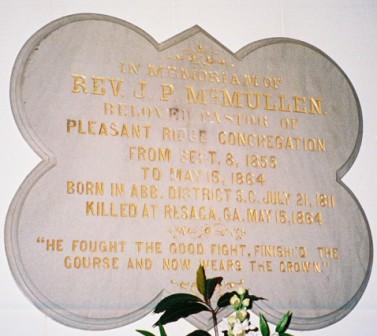
In Memoriam of Rev. J P McMullen
Beloved Pastor of
Pleasant Ridge Congregation
From Sept. 8, 1855
To May 15, 1864
Born in Abb. District S.C. July 21, 1811
Killed at Resaca, GA May 15, 1864
"He Fought The Good Fight, Finished The
Course and Now Wears the Crown"
Leroy H. Archibald, was the son of Robert and Mary Archibald and brother of Robert
N. Archibald, enlisted in Company B, 36th Alabama Infantry on May 1, 1863. On July 22,
1864 he was captured near Atlanta, Georgia. He was taken to Nashville, Tennessee, and on
July 30, 1864 transferred to the military prison at Louisville, Kentucky. The next day he
was sent to Camp Chase, Ohio, where he arrived August 2. On December 8, 1864, Leroy H.
Archibald died of typhoid pneumonia and was buried at Camp Chase.
Edward Mayes Archibald was the son of Robert and Mary Archibald and brother of
Robert N. Archibald. He was received on examination by the Session on November 7, 1859. On
August 22, 1863 he enlisted in Company B, 7th Alabama Cavalry for the duration of the war.
During the Federal investment of Fort Morgan on Mobile Point, Edward was captured by
elements of the U. S. Navy. The next day he was confined at Fort Pickens, Pensacola,
Florida. In early September 1864 he was transferred to prisoner of war facilities at the
Steam Levee Press No. 4 in New Orleans, Louisiana. On September 29 Edward was admitted to
the St Louis U. S. A. General Hospital, New Orleans, Louisiana for diarrhea. He was
released from the hospital October 5, 1864, on which day he was shipped to Ship Island,
Mississippi. Edward was then transported on November 5 to Fort Columbus, New York Harbor,
New York, where he arrived on November 16, 1864. The next day he was admitted to the
U.S.A. General Hospital, Fort Columbus, New York, due to chronic diarrhea. He was to be
transferred to Elmira, New York, on November 19, but due to his illness he remained in the
hospital at Fort Columbus. On December 17, 1864, Edward M. Archibald died from chronic
diarrhea at Fort Columbus. He was buried in grave number 1269, Cypress Hill Cemetery near
Fort Columbus, Governor=s Island, New
York.
Abner Elmore Steele, son of William Steele, founding elder, was received into
membership of the church on September 20, 1860, on examination by the Session. He enlisted
in Company C, 11th Alabama Infantry on June 11, 1861 at Clinton for the duration of the
war. He was present with the regiment from June to October 1861, though October 24, 1861
he was sent to Richmond on order of the regimental surgeon. Though there is no hospital
record of his admission, he did receive a furlough December 7, 1861, apparently when he
was released from the hospital. Abner Elmore Steele was wounded in action on June 30, 1862
in the Battle of Malvern Hill, but there is no record of admission to a hospital for these
wounds. He was admitted to the General Hospital, Staunton, Virginia, on October 13, 1862
for convalescence from a fever, after the retreat from Maryland following the battle of
Sharpsburg. He was admitted to the Chimborazo Hospital No. 4, Richmond, Virginia, on
November 9, 1862, for typhoid fever. Elmore was transferred to Petersburg, Virginia on
November 14. He received another furlough March 23, 1863 after his release from the
hospital. He apparently was present with the regiment the first half of 1864, but a
company muster roll of October 1864 lists him as absent, missing since August 16 and
assumed to be a prisoner. Federal prisoner of war records indicate he was captured at Deep
Bottom, Virginia, August 17, 1864, at the camp hospital. He was transferred from City
Point, Virginia to Point Lookout, Maryland August 22. Elmore was paroled at Point Lookout
on February 10, 1865, and transferred for exchange. He was among 2051 paroled Confederate
prisoners of war exchanged and received by Confederate officers on February 14/15, 1865 at
Coxes Landing, James River, Virginia. He was admitted to the Receiving and Wayside
Hospital/ General Hospital No. 9, Howard=s
Grove, Richmond, Virginia, February 15, 1865. Abner Elmore Steele died March 12, 1865 at
the General Hospital, Howard=s Grove,
Richmond, Virginia. During the war he had suffered numerous attacks of typhoid fever and
had been wounded in action.
After the War, the church was faced with the challenge of continuing after the loss of
its pastor and ten of its membership. During 1864 and 1865 Rev. A.P. Silliman and Rev. C.
A. Stillman supplied the pulpit. On March 28, 1866, Rev. Cornelius Marion Hutton
was called to be second pastor of the Pleasant Ridge Presbyterian Church.
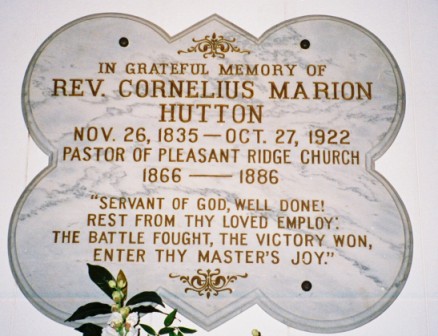
Mr. Hutton was the son of William J. and Ann Hutton of Clinton, Greene County. He was
born November 26, 1835 in Clinton. He was first under the instruction of Dr. Henry
Tutwiler on Greene Springs School before he entered the University of Alabama in 1854 and
graduated in 1857. He was offered a chair on the faculty at the University but declined it
to answer the call of the ministry. He taught near Clinton, Alabama for one year before
entering the Theological Seminary at Columbus, South Carolina in the fall of 1858, where
he remained two years. He was licensed and ordained to preach in 1860, becoming the pastor
of Bethel Presbyterian Church in Sumter County, Alabama.
War came and Cornelius Hutton was elected chaplain for the 36th Alabama Infantry
regiment, which work he began in October of 1862 in camp four miles west of Mobile. He
held nightly prayer meetings with the soldiers as he labored to meet the spiritual and
physical needs of the men. From Mobile the regiment was sent to Tullahoma, Tennessee, then
to Manchester, Tennessee on May 24, 1863. He endured the hardships of war, even becoming a
prisoner, for in June 1863 after the heat of battle, the Confederates were surrounded by
the Northern army and surrendered. Mr. Hutton became a prisoner of war with the rest of
the regiment and was sent to Nashville Military Prison. There he ministered the Gospel
even to them in prison. After his parole and release, his work continued among the
soldiers, including the erection of a brigade church in Dalton, Georgia. Mr. Hutton=s chaplaincy ended in February 1864 when he
was ministering to the army at Rocky Face Mountain.
In 1864 he married Miss Jennie E. Gordon of Greene County. After the war he resumed his
pastorate at Bethel Church in Sumter County. On answering the call of the Pleasant Ridge
church, Mr. Hutton was also pastor of the Bethesda Church in Pickens County. He also
taught in the Pleasant Ridge Academy. On May 31, 1870 the Pleasant Ridge church voted to
secure Mr. Hutton as full time pastor, $900 being raised by subscription for his call.
During this time the church held in August of 1870, in addition to regular Sunday
worship services and Wednesday evening prayer meetings, a series of meetings resulted in
the addition of twenty-three white and African Americans to the church. The Sabbath
(Sunday) School was very well attended, with one hundred and nineteen on the rolls. The
African American Sabbath School was also well attended. In the special services in August
twenty to forty attended, and when the series ended August 28, 1870, nine African American
adults were added to the church membership by examination. The church reported a total of
sixty-four communicant members in 1870. With the growth of the flock, two elders were
elected and installed October 27, 1870: John J. Steele and Andrew Sidney Steele.
In December of that year Stephen F. Nunnelee was elected Ruling Elder.
In 1871 Mr. Hutton preached at eleven o=clock
Sabbath services and held an evening Bible class, which was attended by most of the
children of the church and many of the community, as well as many adults. The Sabbath
School continued to grow, reporting a roll of 145. Fifteen in the Sabbath School were
received into church membership during this year. The young men of the church and Sabbath
School conducted their own prayer meetings. The African-American Sabbath School and other
services continued but it was felt that there was some lack of interest in these services.
The Sabbath School continued to flourish the next year, 1872, and the young men organized
themselves into a weekly Christian Association. The membership of the church reached its
greatest in 1873, with 117 members on the active church roll. The next year, 1874, the
church counted 110 communitant members. With the death of Deacon Samuel Archibald on
September 12, 1872, the church elected and installed its third deacon, Thomas P.
Archibald on November 3, 1872. This same day, Ruling Elders James N. Evens and William
Henry Vernier were elected and installed by the church.
However, by 1875 the membership was less than 100; by 1879 the church counted 66 active
members. This was due mostly to the fact that regular worship was held only once a month
and on fifth Sundays as they occurred. Sabbath School was held each Sunday with good to
moderate attendance. There was declining interest among the African-American membership
during these later years. By 1885 the Session perceived that the church could no longer
minister to this segment of the community, for the African-American members had left the
church, and segregated themselves in churches of their own. During this time the church
elected and installed two deacons, Robert S. Archibald and Samuel Miller
Archibald, on March 11, 1877. The next year, on April 7, 1878, the Session was
expanded with the election to Ruling Elder of
Dr. Samuel S. Murphy, H. B. P. Sanders, and Samuel Miller Archibald.
In 1884 Mr. Hutton=s wife died, and in
1885 he married Mrs. Laura Burke of Georgetown, Texas. In 1889, the Hutton family moved to
Temple, Texas. He pastored several churches in Texas and served on the Home Mission Board
in that state until his death in 1923.For the period of nearly twenty years of C.M. Hutton=s ministry in Pleasant Ridge, 120 members were
added to the church membership.
On April 5, 1888, Rev. Robert Morgan was called to serve this church as
pastor for one fourth of his time and in addition the 5th Sunday. The remainder of his
time was to be given to the Oak Grove Presbyterian Church (now First Presbyterian Church
of Aliceville). This arrangement between the two churches continued until 1954 when this
church began having two early morning services per month. Mr. Morgan continued as pastor
until 1890. The church about this time elected two deacons, duly installed: James Hall
Archibald (II) and Charles Stillman Steele. In 1891, Robert S. Archibald
and David M. Montgomery were elected Ruling Elders.
Rev. Francis Murry was pastor from 1890 to the end of 1893. During 1894 Rev
Robert Latimer was stated supply.
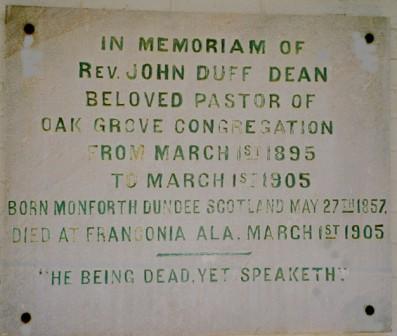
On January 7, 1895, a call was extended to Rev. John Duff Dean, and his
pastorate lasted until March 1905. During Mr. Dean's pastorate Samuel A. Grantham was
elected and installed a deacon. In 1895 Robert P. Matthews was elected Ruling
Elder. On May 10, 1897, Hugh Lafayette Owens was elected Ruling Elder, serving
until his death in 1915. On June 21, 1904, Samuel A. Grantham was elected Ruling
Elder, and Andrew B. Archibald was elected to the Diaconate. Rev A. E. Grover
was pastor from 1905 to 1909. Rev. T. R. Best pastored from 1909 to 1911, during
which time Marcus A. Grantham was elected Ruling Elder; Rev. R. L. Simpson
pastored from 1913 to 1917, Rev. J. C. McQueen from 1918 to 1922; Rev. Solon T.
Hill from 1923 to 1930; Rev. John S. McFall, Jr. from 1930 until his sudden and
seemingly untimely death on September 11, 1931. During this period the to the Session were
added Joel W. Grantham in 1914, and H. B. Summerville in 1915. In 1916 the
Diaconate consisted of William Taylor Horton, Will Steele, Everett C.
Owens, Sr., Elmo Lafayette Owens, and Thomas Earle Norwood.
Rev. Robert F. Sloop served as pastor from 1932 to 1937. Rev. C. Lewis Morrison
from 1938 to 1944. In 1938 the Diaconate was comprised of: William Taylor Horton,
Will Steele and his son William Martin Steele, Sr., Everett C. Owens, Sr.,
Thomas Earle Norwood, and Eugene Jones. Rev. Joseph Dunglinson, D.D.,
after serving one year as stated supply was installed as pastor on September 1, 1946, and
he served through April of 1954. During this time, in 1848, the church celibrated the
centennial of its founding with a special worship service followed by dinner on the
grounds.
Rev. Leland C. Jorgensen served as pastor from May 1, 1954 to 1958; Rev. John
Preston Simmons served from June 1959 through December 1972 and Rev. Charles L.
Wilson from January 1973 to September 1974. Rev. Thomas G. Kay, Sr. served as
pastor from February 1975 to August 1984.
It was during this time the Pleasant Ridge church along with the First Church
Aliceville inherited 385 acres of property and funds from Marcia Horton Speir. Most of
these were used in a renovation project on the church building, including installation of
central air conditioning and new chandeliers with refinishing of the original pine floors.
Rev. Edward Spencer, Jr. became pastor in May 1986 and continued until February
1993. Mr. Kay served as stated supply thence until January 1, 1994 when his son, Rev.
Thomas G. Kay, Jr. was installed as pastor.
xxxxxxxxxxxxxxxxxxxxx
Sources: Information for this narrative has been taken from U.S. Census returns,
Schedules I, II, and IV, of Greene County, Alabama, Land and Marriage Records of Greene
and Pickens counties, Session minutes and rolls of the Pleasant Ridge Presbyterian Church,
tombstone inscriptions at Pleasant Ridge Presbyterian Church cemetery, Alabama Confederate
Pension applications, Compiled Confederate Service records obtained from the National
Archives, interviews with family and others who lived in Pleasant Ridge.
Prepared by:
Scott Wilburn Owens
5254 B Lott Road
Eight Mile, Alabama 36613
251-649-2146
Email: ANRKEE@aol.com
|